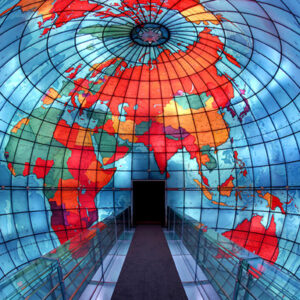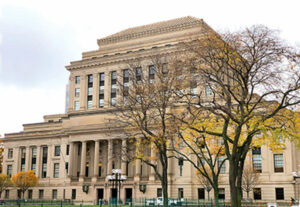By Jane Keller Gordon, Assistant Editor

Boston – It’s worth a trip to visit The Mapparium®, a three story 3D multicolored illuminated globe of the world as it was in 1935. The globe is located at the Mary Baker Eddy Library®, 200 Mass. Avenue.
In the early 1930s, Boston architect Chester Lindsay Churchill, who designed the Christian Science Publishing Society Headquarters, conceived of The Mapparium to represent the mission of the Christian Science Monitor, “… to injure no man, but to bless all mankind.” He was inspired by a huge globe he saw at the headquarters of the Daily News in New York City.
The globe is based on the 1934 Rand McNally World Map. No more than 35 people at a time may view the inside-out representation of the world from a bridge that expands across the sphere’s middle. Over the years, more than 10 million people have viewed the globe.
Teddy Crecelius, who is in charge of group tours at The Mapparium and the adjacent church, commented, “The map is to scale. Unlike a flat printed map in which Greenland is huge, here every size is accurate.”
Curved pieces of glass, in red, orange, yellow, green, blue, and violet (the colors of the rainbow minus indigo), held in a bronze lattice, form the sphere. According to Schuyler Sackett, artistic director and master tour guide, blue is reserved for oceans, seas and lakes. The remaining five colors make up the land.
It was customary in 1935 for political maps to show a colonial power and its territories in the same color. For example, the United Kingdom and all lands under the British crown are red (including independent Commonwealth nations, such as Canada and Australia)… However, with only five colors for all the lands in the world, not all red places are British, and not all green places are French. Violet is used for the Portuguese empire (including Angola and Mozambique) as well as the Japanese empire (which in 1935 included Taiwan and Korea).
The initial idea was to update the pieces of glass as nations and boundaries changed, and that did happen when Persia became Iraq around the time the globe was completed. But, overtime, it was clear that change was too frequent, and that replacement pieces of glass were too expensive. Also, it was decided that the frozen image of a world before WWII is powerful.
“On the whole, I think (viewing the 1935 map) supports a sense of progress – looking back to an era when vast regions were colonial territories, including most of southern Asia and almost all of Africa (except Egypt, Ethiopia and Liberia). Today, national self-determination is the standard nearly everywhere. Visitors love spotting the changes – especially people from countries that have gained independence since 1935,” Sackett said.
Change did come to The Mapparium in 2002 when the original electric bulbs were replaced with LED lights, a sound system was added, and the heating and air conditioning systems were upgraded. The long-lasting LED lights can create up to 16 million colors. Now sound and visual shows are presented on the globe.
The unique acoustics of The Mapparium can be experienced on the bridge. A person standing on one end, whispering, can be heard by another standing at the other end.
“Speaking from the middle of the bridge, others can hear you, but only the person speaking hears a ‘surround-sound projection’ of their own voice,” said Crecelius.

Visitors to The Mapparium can also experience guided tours of the Christian Science Reading Room, the original church built in 1894, and the First Church of Christ, which is located in an adjacent building. The Christian Science Monitor Weekly, Christian Science Journal and other publications are published in the plaza.
The Mapparium can be reached from the Prudential, Symphony, Hynes and Massachusetts Avenue subway stations, and the T1 and T39 buses. The entrance to parking is off Huntington Avenue.
Twenty-minute-long guided tours are offered seven days a week from 10 a.m. to 5 p.m.
The cost is $4 for seniors (62+) and parking at the nearby Christian Science garage below the plaza is validated.
For more information about The Mapparium®, visit mbelibrary.org, and about the plaza, visit christianscienceplaza.com.
Photos/submitted












